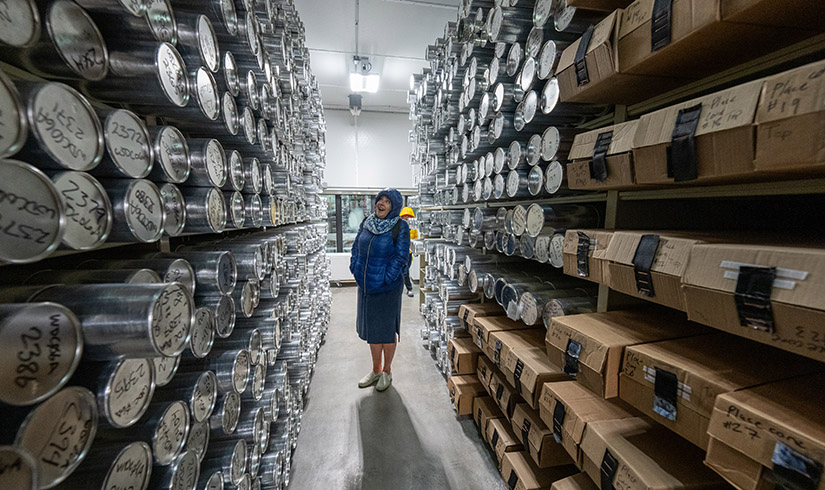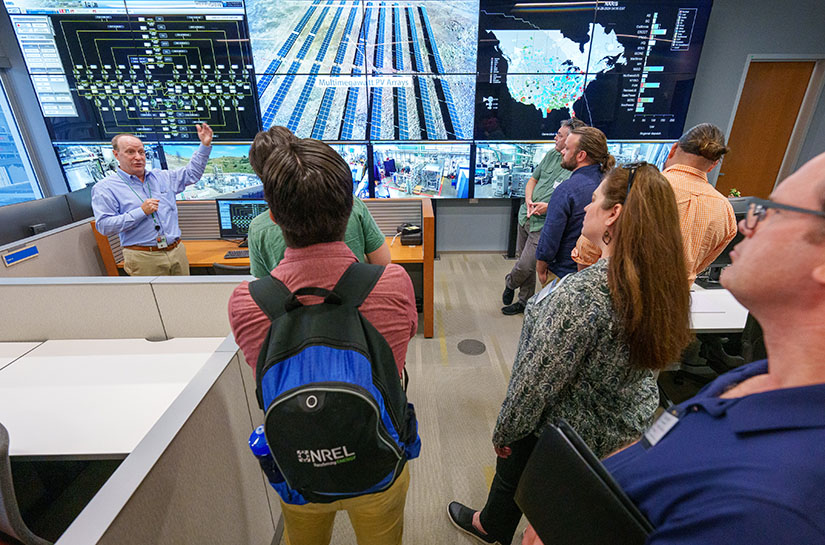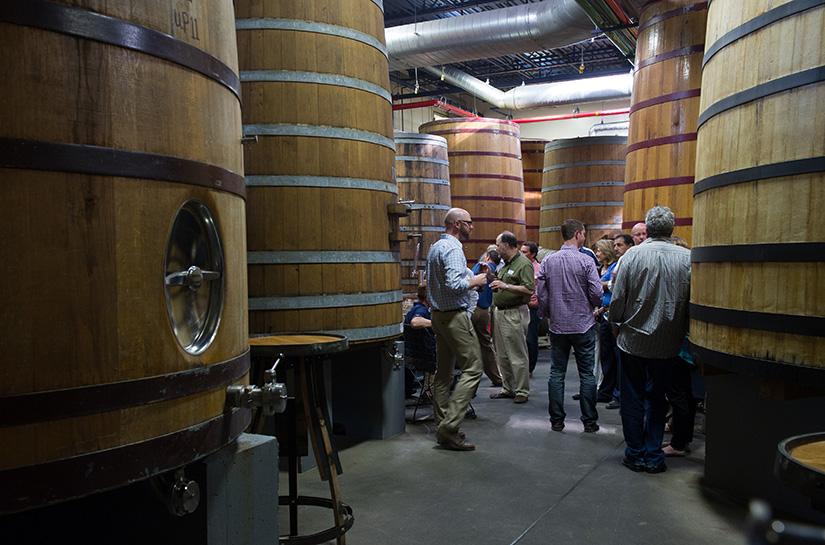15 Years In, Energy Execs Program Participants Keep Making a Difference

When Heather Halkola talks about the Executive Energy Leadership Academy program at the U.S. Department of Energy’s National Renewable Energy Laboratory (NREL), also known as Energy Execs, she thinks of it as a win-win-win.
“I didn’t fully know what it was about, it just looked challenging technically, with accomplished people and at an awesome location,” said Halkola, an energy engineer at the Veterans Affairs Health Care System in Palo Alto, California. “It was an amazing experience. It reminded me of being in the classroom again with motivated people interested in a similar topic and focused on making a difference.”
The Energy Execs program started more than 15 years ago. It invites executives interested in learning more about advanced energy and energy efficiency technologies to NREL repeatedly over the course of several months. During the visits, participants learn about different technologies at the laboratory and often get to go into different buildings on NREL’s Colorado campuses. Additionally, many of the visits entail going off-site to learn about cleantech outside of the lab.
“You went from one session, thinking, ‘This was so amazing,’ to another session you thought was even better,” Halkola said. “Each topic was taught by leading experts. They were able to explain at a very detailed technical level and show cutting-edge technologies.”
Halkola participated in the most recent classes held over the summer in 2023, whereas Don Fitzmartin participated in the inaugural Energy Execs class in 2007. He owns his own company, Fitzmartin Consulting, where he and his team manage design and construction for new commercial buildings or renovations. He ended up in the first program after he participated in the founding class of the Colorado Energy Coalition. Each member of the Coalition chose a project to present on where they could enact clean energy technologies. In Fitzmartin’s case, it was a building modernization where he chose to evaluate six traditional mechanical systems and two nontraditional mechanical systems while studying impacts to capital expenditure, building valuations, and operation expenses.
“Janice Rooney from NREL was there, and after my presentation she asked if I would be interested in participating in a cutting-edge renewable and energy efficiency program to pioneer commercialization into mainstream applications,” Fitzmartin said. “I could not pass up this moment-in-time opportunity to learn from one of our federal labs on how to be a leader in cost-effective sustainability.”
Former NREL employees Carol Tombari and Rooney created the program at NREL in 2007, which is now managed by Public Relations Team Lead Tim Miller.
“The hope is that what they learn from us, they can then take that back to their respective community, business, or other organization and use the information they learned to help advise on their own future renewable energy or sustainability policies and procedures,” Miller said.

Even in its first year, Fitzmartin found the program mesmerizing and said it exposed him to many renewable technologies including solar, wind, efficiency, and bioenergy. He used the lessons he learned for new projects.
“After graduating from the program, I was a partial recipient of a grant to cover NREL’S soft costs for energy modeling and design input on a project of my choosing,” Fitzmartin said. “With an extremely tight budget and phased construction, we were still able to reduce energy by 37% on five floors in a high-rise in downtown Denver. With an ROI [return on investment] within 3.15 years, the NREL assistance was a great differentiator for those selecting my services. When you look at global changes and the potential for climate change, it’s something we can’t afford to be wrong about. We are always looking for consistent improvements in how we manage renovations and new buildings while producing less of a carbon footprint.”
Brett Jackson went through the program in 2012, hoping to connect with other likeminded professionals and subject matter experts at the laboratory, as well as in industry, to complement the knowledge base and experience already gained during his career.
“It was clear to me there were major energy transitions happening, and I wanted to be on the forefront,” said Jackson, current senior energy project manager for Colorado Springs Utilities. “We toured the Vestas wind plant in Windsor [Colorado], as well as a carbon fiber manufacturing office near Windsor, to understand a lot more about what goes into building wind turbines that the industry would be relying upon.”

Jackson and the rest of the Energy Execs participants visited Greensburg, Kansas, where a tornado destroyed 97% of the town in 2007. Residents rebuilt the town with several more energy-efficient buildings. Photo by Dennis Schroeder, NREL
Jackson’s class also visited Greensburg, Kansas, where a tornado caused massive damage in 2007. During the redevelopment of the town, clean energy practices were incorporated in the rebuild, which resulted in the highest per-capita concentration of LEED-certified buildings in the United States. During the visit, one of the common themes was the importance of planning for both the actual rebuild and post-construction when the experts depart and the locals are left to operate and maintain the new systems and infrastructure.
“It gave me a good understanding of the full life cycle,” Jackson said. “We were seeing the clear-cut challenges in understanding how to operate, maintain, and utilize the new technologies. It helped us understand what the implications are for decisions made in the clean energy space.”
More than 10 years later, Halkola had a similar experience in reassessing her approach to technology and making sure it is implemented and maintained correctly.
“It wasn’t just a technology learning experience. It was technology, community, and how to plan for the future,” she said. “It was inspirational, and it made me want to continue learning. The energy transition can be implemented everywhere: at work, home, schools, traveling.”

Even though Fitzmartin went through the class 15 years ago, he still applies lessons from it today.
“We’re working on a 44-acre development in northern Colorado,” he said. “We performed system evaluations, and we are now giving strong consideration for geothermal as a potential solution for this user.”
Fitzmartin is also looking at installing electric vehicle (EV) charging stations in downtown Denver, focusing on reducing the conception timeline from six months to three months. His experiences in the Energy Execs program helped him connect with decision makers at the highest levels to realize results.
“It was a very intense program,” Fitzmartin said. “I felt like I was getting a master’s in renewables on a fast track. I had immediate access to the best minds in the industry for renewables and efficiencies, with instant answers to any question I had. It created enthusiasm and momentum to where you wanted to improve, come back, and show results. It was really the red-carpet treatment. I was just very appreciative of it, and I highly recommend it.”
Jackson believes the lessons he learned can accelerate the pace of the nation’s energy transition challenge, and it gave him a sense of community within industries that look to embrace the energy transformation.
“The Energy Execs program provided me a lot of knowledge, resources, and understanding in the industry,” he said. “It’s a perfect program to enable professionals to level up or get to the next rung in their professional pursuits.”
For Halkola, the push toward a renewable energy future is personal. She wants to do it for her two children.
“I want my children and my grandchildren to be able to enjoy the beautiful outdoors,” she said. “Without this transition, certain areas of the earth are being impacted and going extinct that I would like to see stay around longer for my children and my grandchildren. I need to do my piece.”
Learn more about the Energy Execs program, including how to apply.
This article has been updated to reflect editorial changes made after its original publication.
Last Updated May 28, 2025
